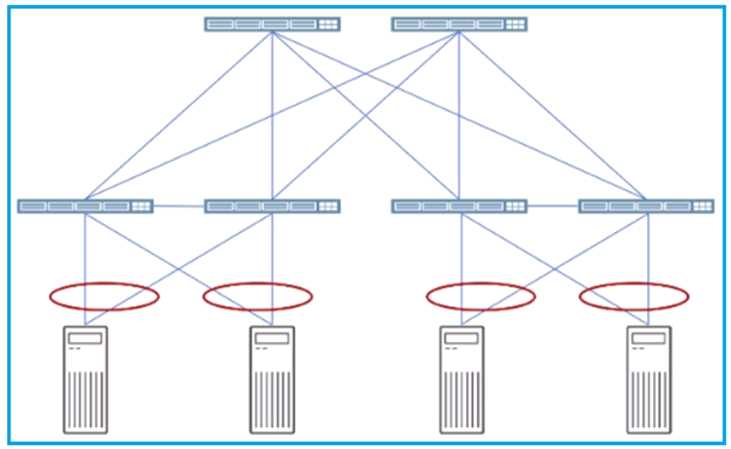Juniper jn0-1302 practice test
Data Center Design, Specialist Exam
Question 1
Your Junos device is configured with dual Routing Engines.
In this scenario, which feature must be activated to preserve both the control and forwarding planes?
- A. graceful Routing Engine switchover only
- B. graceful Routing Engine switchover with graceful restart and non-stop routing
- C. graceful Routing Engine switchover with graceful restart
- D. graceful Routing Engine switchover with non-stop routing
Answer:
D
Question 2
What are two overlay protocols that should be considered in your data center design when using an
IP fabric underlay? (Choose two.)
- A. OSPF
- B. VXLAN
- C. MPLSoGRE
- D. VPLS
Answer:
BD
Question 3
Which three statements about Contrail Networking are true? (Choose three.)
- A. It is used to service chain network functions.
- B. It is used to program physical network functions.
- C. It is used to virtualize and program networks.
- D. It is used to virtualize and program compute.
- E. It is used to create distributed cloud storage.
Answer:
ACE
Question 4
Two data centers must be able to operate with a stretched Layer 2 network. You are concerned about
unnecessary traffic on the Data Center Interconnect (DCI). You do not want packets to trombone over
the DCI, have excessive unknown unicast packet flooding over the DCI, or have excessive ARP
flooding over the DCI.
Which technology satisfies the requirements in this scenario?
- A. EVPN
- B. IPsec
- C. VPLS
- D. GRE over IP
Answer:
A
Question 5
You have a heavily virtualized environment in which all of your virtual machines are hosted on a few
large, shared servers. For security reasons, you must restrict inter-VM traffic and only allow traffic
that complies with your security policies.
Which two technologies would you use to restrict inter-VM traffic? (Choose two.)
- A. URL filtering
- B. security intelligence
- C. vSRX
- D. VLAN
Answer:
CD
Question 6
You are responsible for the uptime of a Clos IP fabric that has an EBGP implementation. When the
EBGP implementation is restarted on a router, it causes a routing flap.
In this scenario, which BGP feature would prevent downtime?
- A. EBGP multihop
- B. BGP route preference
- C. EBGP local preference
- D. BGP graceful restart
Answer:
D
Question 7
You are performing a risk assessment on your new data center. You must determine the annual loss
expectancy.
Which two calculations must you use in this scenario? (Choose two.)
- A. single loss expectancy
- B. asset value
- C. annual rate of occurrence
- D. exposure factor
Answer:
AB
Question 8
You want to reduce the over-subscription ratio of an IP fabric between the leaf nodes and spine
nodes.
Which two actions will accomplish this goal? (Choose two.)
- A. Add spine nodes to the fabric.
- B. Increase bandwidth between the spine and leaf.
- C. Add leaf nodes to the fabric.
- D. Add aggregate links to the servers.
Answer:
AB
Question 9
Which two statements about a three-stage Clos IP Fabric architecture are correct? (Choose two.)
- A. Each server-facing interface is always two hops away from any other server-facing interfaces.
- B. Each leaf node should have a physical connection to every other leaf node.
- C. No physical connectivity exists between spine devices.
- D. Each server-facing interface is always one hop away from any other server-facing interfaces.
Answer:
CD
Question 10
You are designing an IP fabric underlay using IBGP with the spines serving as route reflectors.
In this scenario, which BGP capability must be supported on the spines?
- A. add-path
- B. route-monitoring
- C. rib-sharding
- D. route-refresh-priority
Answer:
A
Question 11
You are designing a Layer 3 Clos fabric architecture for a new data center network infrastructure. You
use IBGP for the underlay control plane of the fabric.
Which devices must support BGP route reflection and BGP ADD-PATH?
- A. spine nodes
- B. leaf nodes
- C. fabric interconnect routers
- D. fabric perimeter routers
Answer:
A
Question 12
Click the Exhibit button.
You need to ensure that no single point of failure exists in a new data center that will be deployed.
Referring to the exhibit, which two technologies will accomplish this requirement? (Choose two.)
- A. Virtual Chassis
- B. LLDP
- C. MC-LAG
- D. LAG
Answer:
AC
Question 13
Which two elements are available to implement security within a vRouter managed by Contrail?
(Choose two.)
- A. Security Policy
- B. Security Group
- C. IPsecVPN
- D. Network Policy
Answer:
BD
Question 14
Which statement is correct about end-of-row (EoR) access switch designs when compared to top-of-
rack (ToR) designs?
- A. Large EoR designs provide more flexibility for connection types.
- B. EoR designs require fewer cable connections to all servers.
- C. EoR designs typically provide fewer access devices to manage.
- D. Large EoR designs minimize the overall cable length required to connect to all servers.
Answer:
C
Question 15
Which two statements are correct when considering redundancy in a data center design? (Choose
two.)
- A. Virtual Chassis is not supported in IP fabric designs.
- B. Routing protocols in an IP fabric must support ECMP.
- C. Redundant power supplies should be wired to the same PDU.
- D. LAG between a server and an IP fabric should be on separate physical leaf devices.
Answer:
BD